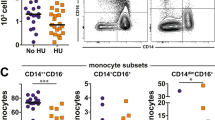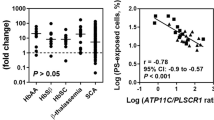Abstract
Recent studies have demonstrated the role of adenosine (ADO) in sickle-cell anemia (SCA). ADO is produced by CD39 and CD73 and converted to inosine by adenosine deaminase (ADA). We evaluated the effects of hydroxycarbamide (HU) treatment on the modulation of adenosine levels in SCA patients. The expressions of CD39, CD73, and CD26 were evaluated by flow cytometry on blood cells in 15 HU-treated and 17 untreated patients and 10 healthy individuals. RNA was extracted from monocytes, and ADA gene expression was quantified by real-time PCR. ADA activity was also evaluated. We found that ADA transcripts were two times higher in monocytes of HU-treated patients, compared with untreated (P = 0.039). Monocytes of HU-treated patients expressed CD26, while monocytes of controls and untreated patients did not (P = 0.023). In treated patients, a lower percentage of T lymphocytes expressed CD39 compared with untreated (P = 0.003), and the percentage of T regulatory (Treg) cells was reduced in the treated group compared with untreated (P = 0.017) and controls (P = 0.0009). Besides, HU-treated patients displayed increased ADA activity, compared with untreated. Our results indicate a novel mechanism of action of HU mediated by the reduction of adenosine levels and its effects on pathophysiological processes in SCA.





Similar content being viewed by others
References
Bunn HF (1997) Pathogenesis and treatment of sickle cell disease. N Engl J Med 337:762–769
Frenette PS (2002) Sickle cell vaso-occlusion: multistep and multicellular paradigm. Curr Opin Hematol 9:101–106
Miller ST, Sleeper LA, Pegelow CH et al (2000) Prediction of adverse outcomes in children with sickle cell disease. N Engl J Med 342:83–89
Wun T, Cordoba M, Rangaswami A, Cheung AW, Paglieroni T (2002) Activated monocytes and platelet-monocyte aggregates in patients with sickle cell disease. Clin Lab Haematol 24:81–88
Belcher JD, Marker PH, Weber JP, Hebbel RP, Vercellotti GM (2000) Activated monocytes in sickle cell disease: potential role in the activation of vascular endothelium and vaso-occlusion. Blood 96:2451–2459
Mi T, Abbasi S, Zhang H et al (2008) Excess adenosine in murine penile erectile tissues contributes to priapism via A2B adenosine receptor signaling. J Clin Invest 118:1491–1501
Zhang Y, Dai Y, Wen J et al (2011) Detrimental effects of adenosine signaling in sickle cell disease. Nat Med 17:79–86
Behdad A, Sun X, Khalpey Z et al (2009) Vascular smooth muscle cell expression of ectonucleotidase CD39 (ENTPD1) is required for neointimal formation in mice. Purinergic Signal 5:335–342
Eltzschig HK, Ibla JC, Furuta GT et al (2003) Coordinated adenine nucleotide phosphohydrolysis and nucleoside signaling in posthypoxic endothelium: role of ectonucleotidases and adenosine A2B receptors. J Exp Med 198:783–796
Resta R, Yamashita Y, Thompson LF (1998) Ecto-enzyme and signaling functions of lymphocyte CD73. Immunol Rev 161:95–109
Franco R, Valenzuela A, Lluis C, Blanco J (1998) Enzymatic and extraenzymatic role of ecto-adenosine deaminase in lymphocytes. Immunol Rev 161:27–42
Gorrell MD, Gysbers V, McCaughan GW (2001) CD26: a multifunctional integral membrane and secreted protein of activated lymphocytes. Scand J Immunol 54:249–264
Cokic VP, Smith RD, Beleslin-Cokic BB et al (2003) Hydroxyurea induces fetal hemoglobin by the nitric oxide-dependent activation of soluble guanylyl cyclase. J Clin Invest 111:231–239
Ikuta T, Ausenda S, Cappellini MD (2001) Mechanism for fetal globin gene expression: role of the soluble guanylate cyclase-cGMP-dependent protein kinase pathway. Proc Natl Acad Sci U S A 98:1847–1852
Kutlar A (2007) Sickle cell disease: a multigenic perspective of a single gene disorder. Hemoglobin 31:209–224
Covas DT, de Lucena Angulo I, Vianna Bonini Palma P, Zago MA (2004) Effects of hydroxyurea on the membrane of erythrocytes and platelets in sickle cell anemia. Haematologica 89:273–280
Kilic S, Salih M, Anafarta K, Baltaci S, Kosar A (1994) Adenosine: a new agent in the diagnosis of impotence. Int J Impot Res 6:191–198
Faria M, Magalhaes-Cardoso T, Lafuente-de-Carvalho JM, Correia-de-Sa P (2006) Corpus cavernosum from men with vasculogenic impotence is partially resistant to adenosine relaxation due to endothelial A(2B) receptor dysfunction. J Pharmacol Exp Ther 319:405–413
Sitkovsky M, Lukashev D (2005) Regulation of immune cells by local-tissue oxygen tension: HIF1 alpha and adenosine receptors. Nat Rev Immunol 5:712–721
Thiel M, Caldwell CC, Sitkovsky MV (2003) The critical role of adenosine A2A receptors in downregulation of inflammation and immunity in the pathogenesis of infectious diseases. Microbes Infect 5:515–526
Hasko G, Linden J, Cronstein B, Pacher P (2008) Adenosine receptors: therapeutic aspects for inflammatory and immune diseases. Nat Rev Drug Discov 7:759–770
Riksen NP, Rongen GA, Yellon D, Smits P (2008) Human in vivo research on the vascular effects of adenosine. Eur J Pharmacol 585:220–227
Sitkovsky MV, Ohta A (2005) The ‘danger’ sensors that STOP the immune response: the A2 adenosine receptors? Trends Immunol 26:299–304
Fredholm BB, Cunha RA, Svenningsson P (2003) Pharmacology of adenosine A2A receptors and therapeutic applications. Curr Top Med Chem 3:413–426
Gessi S, Varani K, Merighi S et al (2007) Adenosine and lymphocyte regulation. Purinergic Signal 3:109–116
Ohta A, Sitkovsky M (2001) Role of G-protein-coupled adenosine receptors in downregulation of inflammation and protection from tissue damage. Nature 414:916–920
Sitkovsky MV, Lukashev D, Apasov S et al (2004) Physiological control of immune response and inflammatory tissue damage by hypoxia-inducible factors and adenosine A2A receptors. Annu Rev Immunol 22:657–682
Koshiba M, Kojima H, Huang S, Apasov S, Sitkovsky MV (1997) Memory of extracellular adenosine A2A purinergic receptor-mediated signaling in murine T cells. J Biol Chem 272:25881–25889
Lappas CM, Rieger JM, Linden J (2005) A2A adenosine receptor induction inhibits IFN-gamma production in murine CD4+ T cells. J Immunol 174:1073–1080
Field JJ, Lin G, Okam MM et al (2013) Sickle cell vaso-occlusion causes activation of iNKT cells that is decreased by the adenosine A2A receptor agonist regadenoson. Blood 121:3329–3334
Scott CR, Chen SH, Giblett ER (1974) Detection of the carrier state in combined immunodeficiency disease associated with adenosine deaminase deficiency. J Clin Invest 53:1194–1196
Thompson LF, Seegmiller JE (1980) Adenosine deaminase deficiency and severe combined immunodeficiency disease. Adv Enzymol Relat Areas Mol Biol 51:167–210
Caboot JB, Allen JL (2008) Pulmonary complications of sickle cell disease in children. Curr Opin Pediatr 20:279–287
Leong CS, Stark P (1998) Thoracic manifestations of sickle cell disease. J Thorac Imaging 13:128–134
Chunn JL, Young HW, Banerjee SK, Colasurdo GN, Blackburn MR (2001) Adenosine-dependent airway inflammation and hyperresponsiveness in partially adenosine deaminase-deficient mice. J Immunol 167:4676–4685
Chunn JL, Molina JG, Mi T, Xia Y, Kellems RE, Blackburn MR (2005) Adenosine-dependent pulmonary fibrosis in adenosine deaminase-deficient mice. J Immunol 175:1937–1946
Vendramini EC, Vianna EO, De Lucena Angulo I, De Castro FB, Martinez JA, Terra-Filho J (2006) Lung function and airway hyperresponsiveness in adult patients with sickle cell disease. Am J Med Sci 332:68–72
Eltzschig HK, Carmeliet P (2011) Hypoxia and inflammation. N Engl J Med 364:656–665
Kong T, Westerman KA, Faigle M, Eltzschig HK, Colgan SP (2006) HIF-dependent induction of adenosine A2B receptor in hypoxia. FASEB J 20:2242–2250
Eltzschig HK, Thompson LF, Karhausen J et al (2004) Endogenous adenosine produced during hypoxia attenuates neutrophil accumulation: coordination by extracellular nucleotide metabolism. Blood 104:3986–3992
Mandapathil M, Hilldorfer B, Szczepanski MJ et al (2010) Generation and accumulation of immunosuppressive adenosine by human CD4 + CD25highFOXP3+ regulatory T cells. J Biol Chem 285:7176–7186
Eltzschig HK, Faigle M, Knapp S et al (2006) Endothelial catabolism of extracellular adenosine during hypoxia: the role of surface adenosine deaminase and CD26. Blood 108:1602–1610
Pulte ED, Broekman MJ, Olson KE et al (2007) CD39/NTPDase-1 activity and expression in normal leukocytes. Thromb Res 121:309–317
Dwyer KM, Deaglio S, Gao W, Friedman D, Strom TB, Robson SC (2007) CD39 and control of cellular immune responses. Purinergic Signal 3:171–180
Holm TL, Nielsen J, Claesson MH (2004) CD4 + CD25+ regulatory T cells: I. Phenotype and physiology. APMIS 112:629–641
Shevach EM, DiPaolo RA, Andersson J, Zhao DM, Stephens GL, Thornton AM (2006) The lifestyle of naturally occurring CD4+ CD25+ Foxp3+ regulatory T cells. Immunol Rev 212:60–73
Walsh PT, Taylor DK, Turka LA (2004) Tregs and transplantation tolerance. J Clin Invest 114:1398–1403
Yu J, Heck S, Yazdanbakhsh K (2007) Prevention of red cell alloimmunization by CD25 regulatory T cells in mouse models. Am J Hematol 82:691–696
Lebensburger JD, Howard T, Hu Y et al (2012) Hydroxyurea therapy of a murine model of sickle cell anemia inhibits the progression of pneumococcal disease by down-modulating E-selectin. Blood 119:1915–1921
McCann WP, Katholi RE (1990) Control of artifacts in plasma adenosine determinations. Proc Soc Exp Biol Med 194:314–319
Acknowledgments
The authors would like to thank Flávia I. S. Ferreira, Patrícia V. B. Palma, Amélia G. Araujo, Regina H. C. Queiroz, Camila C. B. O. Menezes, and Marli H. Tavella for their assistance with the laboratory techniques and Sandra Navarro Bresciani for assisting in the preparation of the figures.
Funding
This work was supported by the following: Fundação de Amparo à Pesquisa do Estado de São Paulo (FAPESP), Conselho Nacional de Desenvolvimento Científico e Tecnológico (CNPq), and Financiadora de Estudos e Projetos (FINEP), Brazil, and by the INSERM (Institut National de la Santé et de la Recherche Médicale), France.
Author contributions
ACSP designed the study, performed experiments, analyzed and interpreted data, and wrote the manuscript. CDC, FSA, FISF, PVBP, AGA, and RHCQ performed experiments, analyzed and interpreted data, and wrote the manuscript. JE, DTC, MAZ, and RAP designed the study, analyzed and interpreted data, and wrote the manuscript.
Conflict of interest
The authors report no potential conflicts of interest.
Author information
Authors and Affiliations
Corresponding author
Rights and permissions
About this article
Cite this article
Silva-Pinto, A.C., Dias-Carlos, C., Saldanha-Araujo, F. et al. Hydroxycarbamide modulates components involved in the regulation of adenosine levels in blood cells from sickle-cell anemia patients. Ann Hematol 93, 1457–1465 (2014). https://doi.org/10.1007/s00277-014-2066-4
Received:
Accepted:
Published:
Issue Date:
DOI: https://doi.org/10.1007/s00277-014-2066-4




